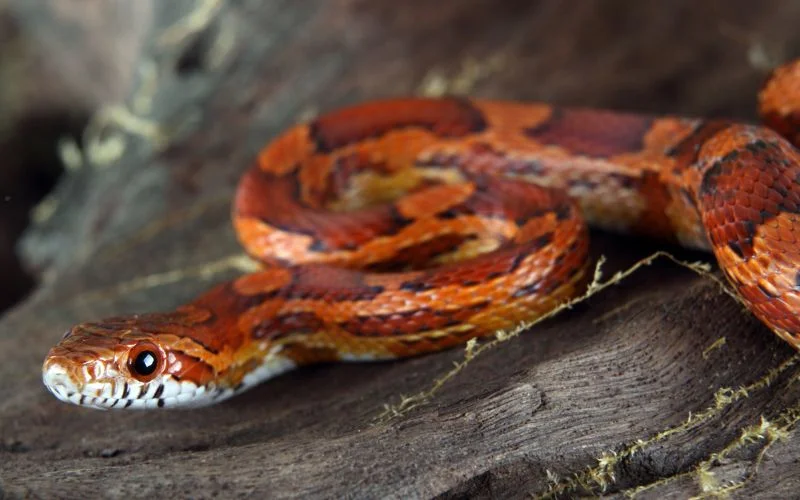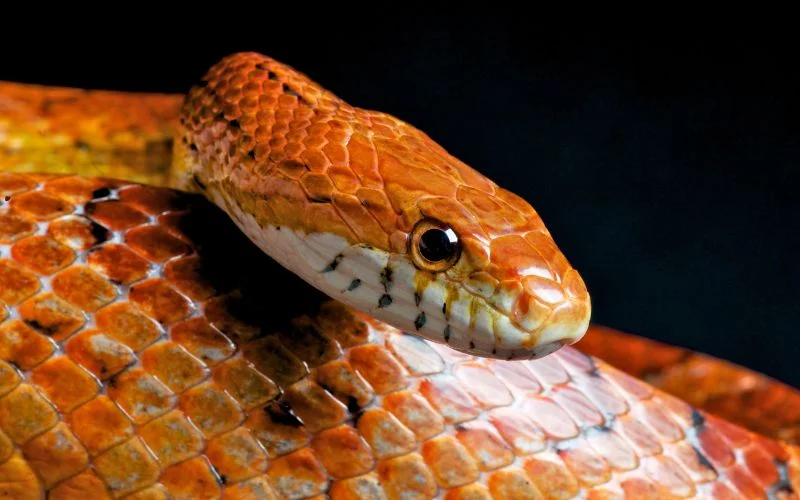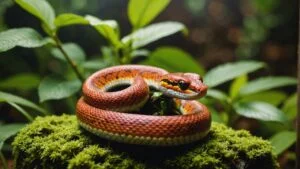When considering adding a corn snake to your family, understanding their lifespan is essential. Typically, these snakes live between 10-15 years in captivity, but have you ever wondered what factors can influence their longevity? It’s not just about genetics; proper care, including diet, habitat conditions, and regular veterinary visits, plays a significant role. You might be curious about the steps you can take to guarantee that your corn snake enjoys a long, healthy life. Let’s explore how you can provide the best environment and care practices to maximize their lifespan.
Key Takeaways
- Corn snakes typically live 10-15 years in captivity with proper care.
- Genetic predispositions and responsible breeding practices significantly influence lifespan.
- Proper enclosure temperature, humidity, and lighting are crucial for longevity.
- Regularly feeding appropriately sized, pre-killed prey supports health and reduces injury risk.
- Maintaining a clean, secure habitat helps prevent infections and escape.
Average Lifespan


Corn snakes live between 10 to 15 years on average in captivity. Various factors, including genetic predispositions and breeding practices, can influence this range. When you’re selecting a corn snake, it’s vital to take into account its genetic background. Certain genetic traits can make some corn snakes more resilient and healthier than others, potentially extending their lifespan.
Breeding practices play a significant role in the average lifespan of these snakes. Responsible breeders focus on producing healthy offspring by selecting parent snakes with good health histories and strong genetic backgrounds. They avoid inbreeding and work to minimize genetic issues that could shorten a snake’s life. When breeders take these steps, your corn snake is more likely to reach or exceed the average lifespan.
In contrast, poor breeding practices can lead to genetic problems, weakening the snake and reducing its lifespan. Choosing a snake from a reputable breeder who emphasizes good genetic predispositions and ethical breeding practices sets the stage for your corn snake to live a long, healthy life.
Factors Affecting Longevity
Beyond genetics and breeding practices, several other factors can greatly impact how long your corn snake lives. One important element is the environment you provide. Ensure your snake’s enclosure mimics its natural habitat with proper temperature, humidity, and lighting. This helps reduce stress levels, greatly impacting your snake’s overall health and longevity.
Another key aspect is properly handling your corn snake. While these reptiles are generally docile, excessive or improper handling can increase stress levels. Limit handling sessions to short periods and ensure your snake feels secure and comfortable.
Cleanliness is also essential. Regularly clean the enclosure to prevent the buildup of harmful bacteria and parasites. A dirty habitat can lead to infections and diseases, shortening your snake’s lifespan.
Lastly, pay attention to genetic factors. Some corn snakes may be more prone to certain health issues due to their genetic makeup. Regular veterinary check-ups can help identify and manage these problems early on.
Optimal Diet
Providing your corn snake with an essential diet is important for its health and longevity. Ensuring proper nutrition means giving your snake the right types of food in appropriate amounts. Corn snakes thrive on a diet primarily consisting of appropriately-sized rodents, such as mice and, occasionally, small rats. Always choose prey no larger than your snake’s widest part to prevent choking or indigestion.
Establishing a consistent feeding routine is essential. Juvenile corn snakes generally need to eat every 5-7 days, while adults can be fed every 7-10 days. Sticking to this schedule helps maintain their metabolism and overall well-being. It’s also important to monitor their weight and adjust feeding frequency to prevent obesity or malnutrition.
Variety in diet isn’t typically necessary for corn snakes, but occasionally offering a different type of prey, like quail chicks, can provide mental stimulation. Always use pre-killed prey to avoid injury to your snake.
Additionally, ensure fresh water is always available, as hydration is key to digestion and overall health.
Ideal Habitat Conditions
Creating an ideal habitat for your corn snake involves maintaining the right temperature, humidity, and space to guarantee its well-being. First, choose an appropriate terrarium size. A 20-gallon terrarium is the minimum for a single adult corn snake, but a larger enclosure offers more comfort and enrichment opportunities. Make sure the terrarium has a secure lid to prevent escapes.
Next, control the temperature. Corn snakes thrive in a temperature gradient, with a warm side between 85-90°F (29-32°C) and a cooler side around 75°F (24°C). Use a heat mat or lamp to provide warmth, but don’t forget to monitor temperatures with a reliable thermometer.
Humidity levels are also important. Aim for a 40-60% range to support healthy shedding and respiratory function. Use a hygrometer to monitor humidity, and mist the terrarium lightly if levels drop too low.
Here’s a quick reference table for ideal habitat conditions:
| Aspect | Ideal Range | Tools Needed |
|---|---|---|
| Terrarium Size | 20+ gallons | Secure lid, ample space |
| Temperature | 75-90°F (24-32°C) | Heat mat, thermometer |
| Humidity Levels | 40-60% | Hygrometer, misting bottle |
Common Health Issues
Like all pets, corn snakes can face several health issues that owners should be aware of. One common problem is respiratory infections. These often occur when the snake’s environment isn’t kept at the right temperature or humidity levels. Symptoms include wheezing, bubbling at the nostrils, and open-mouth breathing. If you notice any of these signs, it’s important to consult a veterinarian experienced with reptiles to get the appropriate treatment.
Another issue to watch for is parasitic infestations. Corn snakes can suffer from both internal and external parasites. Mites and ticks are the most common external parasites, while internal ones include worms and protozoa. Symptoms of a parasitic infestation might include lethargy, irregular shedding, and loss of appetite. Regularly cleaning your snake’s enclosure and performing routine health checks can help prevent these infestations.
Maintaining a clean habitat and providing proper care are essential to avoiding these health issues. If you suspect your corn snake is suffering from either respiratory infections or parasitic infestations, prompt action can make a significant difference.
Always watch your pet’s health to ensure a long, happy life.
Signs of Aging


As your corn snake matures, several aging signs indicate it’s entering its later years. One prominent sign is scale discoloration. Your snake’s once vibrant and uniform scales might start to fade or develop uneven patches. This change in appearance usually signals a natural part of the aging process and isn’t necessarily a cause for immediate concern.
Behavioral changes can also be a clear indicator of aging in corn snakes. You might observe that your snake becomes less active and rests more. It may also show a decreased interest in food, eating less frequently than it did in its younger years. This reduced activity level is typical as the snake’s metabolism decreases with age.
Additionally, your snake might exhibit slower, more deliberate movements and take longer to shed skin. In some cases, you might notice that the snake becomes less responsive to stimuli, such as handling or feeding cues. These behavioral changes and physical signs like scale discoloration are natural parts of your corn snake’s aging process. Knowing these signs helps you understand and care for your aging pet more effectively.
Tips for Extending Lifespan
Ensuring your corn snake lives a long, healthy life involves providing proper care and attention to its specific needs. One of the most important aspects is stress reduction. A stressed snake is more prone to health issues, so maintaining a calm environment is crucial. Avoid loud noises and sudden temperature changes. Ensure the enclosure is appropriately sized, well-ventilated, and has hiding spots.
Regular handling can also contribute to your snake’s longevity. It helps them stay accustomed to human interaction, which reduces stress. Handle your corn snake gently and frequently, but not immediately after feeding or during shedding cycles.
Here’s a quick table to summarize key tips:
| Tip | Description |
|---|---|
| Proper Diet | Feed appropriately sized prey at regular intervals. |
| Clean Environment | Keep the enclosure clean to prevent disease. |
| Temperature Regulation | Maintain a proper temperature gradient. |
| Humidity Control | Ensure adequate humidity to support shedding. |
| Regular Vet Visits | Schedule check-ups to catch any health issues early. |
A balanced diet, a clean habitat, and regular vet visits are also essential. By following these guidelines, you’ll help your corn snake thrive and possibly extend its lifespan significantly.
Conclusion
To guarantee your corn snake lives a long and healthy, focus on providing the best care possible. Maintain ideal diet and habitat conditions, stay vigilant for common health issues, and schedule regular vet check-ups.
By recognizing signs of aging and addressing them promptly, you’ll help extend your snake’s lifespan. Responsible breeding practices also play an essential role, so choose breeders wisely.
With dedication and proper care, you’ll enjoy many happy years with your corn snake.


